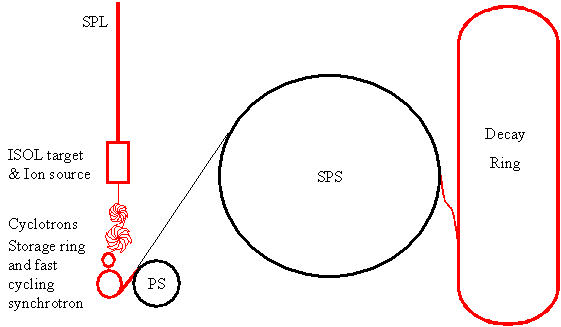![]() Mandate
Mandate
![]() Study group members
Study group members
The demand for better neutrino beams is correlated with the considerable improvement in neutrino detectors, and to the recent exciting claims of evidence for neutrino oscillations by various experiments. In particular, solar, atmospheric and accelerator neutrinos appear today to oscillate (and therefore should have non-zero masses) in a way that it is hard to accommodate in a unique picture, given current theoretical understanding. Speculation and ad-hoc theories abound in the absence of decisive experiments. Obviously, a high intensity neutrino source of a single flavour, improved backgrounds and known energy spectrum and intensity could be decisive both for oscillation searches and precision measurement of the lepton mixing parameters.
The term beta-beam has been coined for the production of a pure beam of electron neutrinos or their antiparticles through the decay of radioactive ions circulating in a storage ring. This concept requires radioactive ions to be accelerated to as high Lorentz gamma as 150. The neutrino source itself consists of a storage ring for this energy range, with long straight sections in line with the experiment(s). Such a decay ring does not exist at CERN today, nor does a high-intensity proton source for the production of the radioactive ions. Nevertheless, the existing CERN accelerator infrastructure could be used as this would still represent an important saving for a beta-beam facility.
The radioactive ions (6He and 18Ne) will be produced in an ISOL system using the proposed Superconducting Proton Linac (SPL) as a driver. They will be ionised, bunched and accelerated with a linac to 100 MeV/u. From the linac they will be injected into a storage ring and ejected to a fast cycling synchrotron for acceleration to 300 MeV/u. The ions will be extracted into the existing Proton Synchrotron (PS) and accelerated to PS top energy in several bunches. Following this they will be transferred to the Super Proton Synchrotron (SPS), accelerated to top energy. Finally, they will be transferred to the new decay ring where they will be merged with the already circulating bunch through a longitudinal stacking procedure. While this might appear straightforward, several bottlenecks exist in this process, not least the bunching at low energy, space charge limitations in the PS and the SPS, decay losses in the acceleration chain and the longitudinal stacking procedure at high energy in the decay ring. The possibility of doing an asymmetric bunch merging is very important for the accumulation of ions in the decay ring
The approved EURISOL Design Study includes the study of a beta-beam facility based on the above outlined scenario.

What is a ‘neutrino’ and why would we want to build a factory to produce them? A short introduction by Andrew Phillips (summer student)